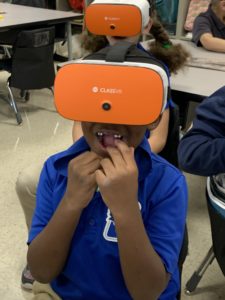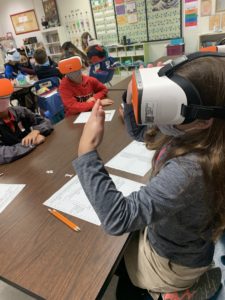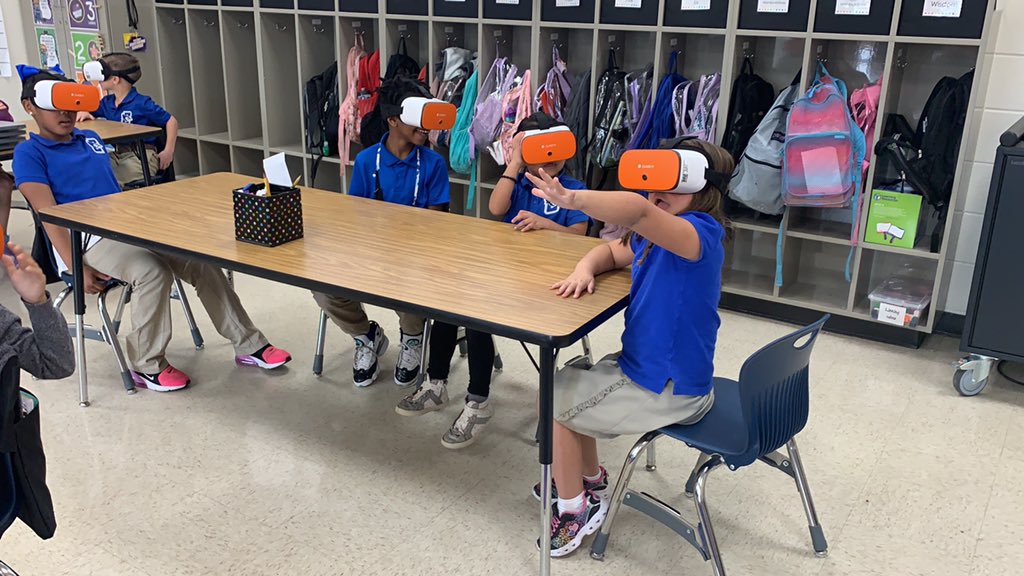Virtual reality technology is a powerful way to pump up everyday classroom lessons and is being increasingly used in schools for everything from language arts to math. At West Baton Rouge Parish Schools, a 4,100-student district in Louisiana, we saw VR as a great opportunity to provide something new to help teachers engage students in the content.

We used ESSER funds to purchase several ClassVR headsets for our district, and, since then, it’s been off-to-the races! Teachers at all grade levels are now integrating VR content into their lessons. We lead the district’s tech team and, along with the teachers, we regularly present about the technology at conferences, including ISTE, FETC and TCEA. And most importantly, our students are reaping the benefits of using VR technology by being able to have virtual experiences that connect them to the curriculum at a deeper level. Here are just a few examples.
VR field trips
This is a popular request from our teachers. We’ve used VR to help students experience the Great Wall of China, the Colosseum in Rome, and many other faraway places without leaving the classroom. We have many students who have never been outside of their own neighborhoods, let alone to other states or countries. We’re right across the river from Baton Rouge, and some of our students have never been to the city.
Virtual reality technology is a great way to help students experience and learn about the world, as well as local landmarks. For us, VR helps show students that the world is bigger than their house or their street or their neighborhood. It opens up their world. It makes them say, “I could go to the Great Wall of China someday or on an African safari.”
If you then connect that to the curriculum, it makes it richer and shows students there are possibilities in life beyond just a small community.
Enhancing curriculum
One of our favorite examples of this is with our third-grade teachers, who use VR to supplement their ELA lessons. They hold “engagement days” when teaching about certain topics like the ocean, immigration or space. On these days, the students break into small groups and complete activities at different stations. One station involves using VR headsets to explore videos about the topic.
For the unit on the ocean, teachers uploaded a VR experience of swimming with sharks and cuttlefish. For the space unit, we used 360-degree videos from NASA. For the immigration unit, the students virtually traveled to places like the Statue of Liberty and the different countries people immigrated from. The VR stations were always a class favorite during engagement days.
Adding fun
Another thing about VR is that it can be just plain fun. One of our all-time favorite fun lessons was in December. The kindergarten students got to go on a field trip to Santa’s Workshop. Using ClassVR headsets and a YouTube 360 video, we gave students the experience of flying in a sleigh with Santa, helping him deliver presents. Teachers can also use this lesson to supplement a lesson about the North Pole.

It was a huge hit. And not surprisingly, after one class did it, the word spread, and suddenly all of the teachers wanted to do it with their classes. One of the best ways to get more teachers using a technology is through word of mouth. This was a perfect example of that.
While virtual reality is a great way to support lessons, training and implementation are important, as they are with any new technology. Here are some suggestions for districts looking to bring virtual reality or any other new technology to their schools.
Spend time planning professional development, and make it interesting. If teachers aren’t comfortable with the technology, they won’t use it. Introducing it in an engaging way is important. Our tech team led a “summer challenge” in which we gamified our PD. Teachers earned points for trying out new tech. For example, if a teacher decided to check out the VR headset to try it at home and reported back to the group or posted something on social media and tagged their colleagues, they would earn points toward t-shirts or mugs.
We find that gamifying PD is effective. It makes it more fun, and teachers feel like it isn’t such a burden. Then, find your “tech evangelists” — the firecracker teachers who want to do all the exciting stuff. Get them to use it. They’re the ones who will get the other teachers on board.
Use tools that are easy to implement. If we have to spend an entire class period working out bugs, it defeats the purpose of having the technology. We’re very particular about selecting technology that won’t require much troubleshooting and that is easy for teachers to use. We do provide training as mentioned above. When a teacher checking out tools — whether it’s Spheros or Lego kits or ClassVR — wants some help, we either send a student worker to help the teacher, or we work directly with the teacher ourselves. To get the best use out of technology, it’s important to select products that are reliable and easy to implement.
Focus on the pedagogy. Technology can help students make connections to books they are reading and topics they are studying. It can be used in everything from ELL instruction to special education. Our goal is for technology to be a tool to support instruction, rather than being the goal itself.
We tell teachers to pick their pedagogy and their teaching strategy, and we’ll help them pick technology that will help them accomplish their goal. The first thing we ask the teacher is “What is the content? What are you teaching?” Then we talk through what we can do to help them from a technology standpoint. Technology is a great way to enhance a lesson and engage students more deeply in content. But don’t force it if it doesn’t make sense.
Technology, when done right, can engage and inspire students and help bring curricula to life. Keeping the considerations above in mind can help schools and districts successfully adopt and implement VR, or any other technology, successfully.
Tammy Seneca, Ph.D., is the supervisor of information systems and educational technology and Stephanie Thompson is the district technology facilitator and professional developer for West Baton Rouge Parish Schools in Port Allen, La. They lead the district’s technology team, provide tech PD for teachers and staff members, and regularly present at education conferences about ClassVR and the other technologies they use to support classroom instruction.
_______________________________
Subscribe to SmartBrief’s FREE email newsletter to see the latest hot topics on EdTech. It’s among SmartBrief’s more than 250 industry-focused newsletters.
